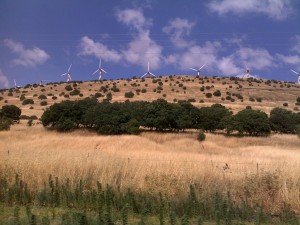Windmill apprentices wanted: Click-clack…click-clack, click-clack the rhythm echoes the heartbeat of the Persian desert wind. For more than one thousand years the people of Nashtifan, in northeastern Iran have heard this sound as they harnessed the “storm’s sting” wind that gave their village its name.
[youtube https://www.youtube.com/watch?v=3qqifEdqf5g]
There are about 30 windmills in the desert near this sand-colored village in the Razavi Khorasan Province of northeastern Iran. Their wooden blades rotate on a vertical axis between high walls of red clay and straw. The 50 to 60 foot high machines make a familiar clatter, like a freight train on uneven track, a blend of urban industrial sounds and the natural whispers of wind in the desert. They serve the same purpose as the more familiar Dutch windmills, they turn a grindstone to turn grain into flour.
But this relic of man’s first attempt to harness the wind for this purpose is a distant ancestor. It is thought to date back to this part of Persia sometime between 500 to 900 AD. One of the earliest records is the story of Pīrūz Nahāvandi who designed windmills and after complaining to Calif Umar of a high tax charged by his master, he promised to build a windmill for Umar, “By God, I will build this mill of which the world will talk.”
The world did talk of these mills. It wasn’t long before windmills spread from Persia into parts of Europe and Asia where they evolved into the more familiar horizontal axis design we see in everything from the wooden windmills that Don Quixote fought in La Mancha Spain to the 200 megawatts of offshore wind that Don Trump fought at his golf resort in Scotland.
There is a good reason for this design change. The flat vertical boards of the Nashtifan windmills are pushed by the wind on one side and unlike designs based on the Bernoulli principle, they can never move faster than the wind and they fight against the wind on the upwind side.
The Nashtifan windmills are neither modern nor efficient, but there is no shortage of wind in this part of Iran. So the mills were maintained and used by local people over centuries as an important part of their culture and history. Mohammad Etebari is the most recent keeper of the windmills.
But unfortunately he has not yet identified an apprentice to take over this centuries old tradition as he grows older. Watch the video and if you know any young person who lives near Nashtifan, ask if they will might take up this long tradition and continue this rhythmic sound in the desert.





One thought on “World’s oldest windmills may stop in Nashtifan, Iran”
Comments are closed.